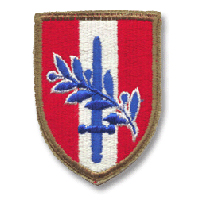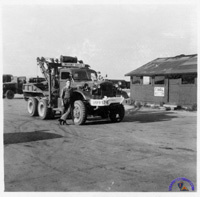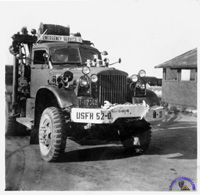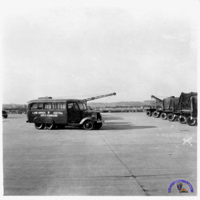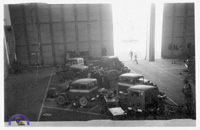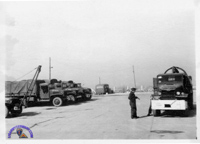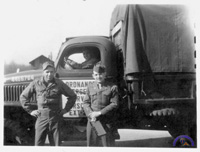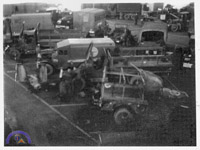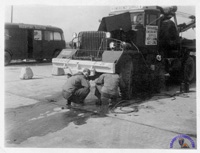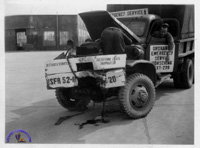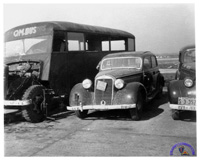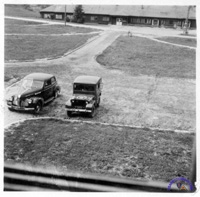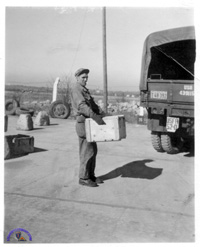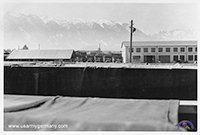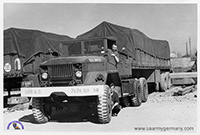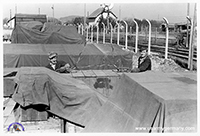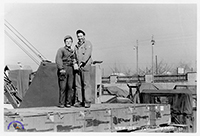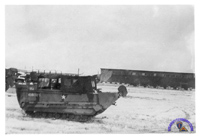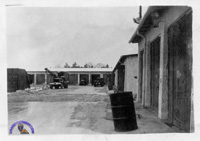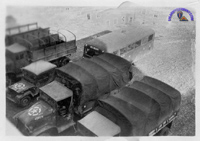If you do
NOT see the Table of Contents frame to the left of this page, then
Click here to open 'USArmyGermany'
frameset |
Ordnance Division
Headquarters, US Forces, Austria
Looking for more information from military/civilian personnel assigned to or associated with the U.S. Forces, Austria from 1945 to 1955. If you have any stories or thoughts on the subject, please contact me . .
|
|
|
|
|
| |
| General Information |
|
| 1953 |
| (Source: STARS & STRIPES, June 3, 1949) |
A brief note in this issue of the S&S (page 2)mentions that the USFA Ordnance Section is located at Spallerhof, Linz.
Also mentions the Gugl Hof Hotel. Might be officers billets.
Can anyone provide additional details? |
 |
|
| |
| 52nd Ordnance Group |
|
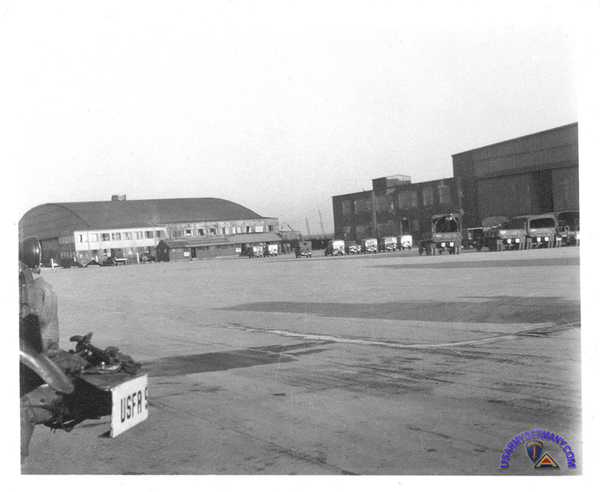
52nd Ordnance Group, Camp McCauley, c. 1947 (Ray Smith) (Bing view) |
|
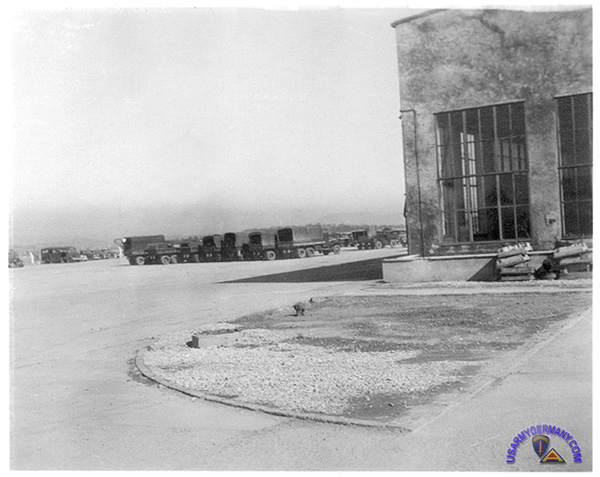
52nd Ordnance Group, Camp McCauley, c. 1947 (Ray Smith) |
|
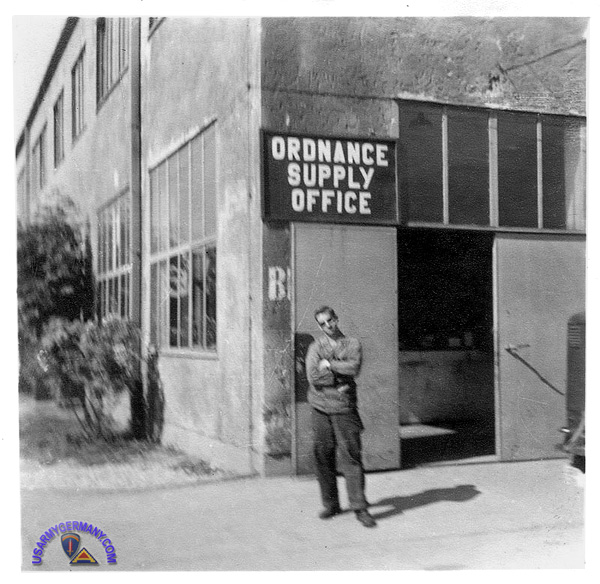
In front of the Ordnance Supply Office, c. 1947 (Ray Smith) |
|
| (Source: 52nd Ordnance Group, Wikipedia, accessed 12/08/2012) |
- Activated 27 December 1943 at Camp Hood, Texas.
- Participated in WWII in the European Theater (Normandy through Central Europe campaigns).
- Reorganized and redesigned 27 May 1946 as Headquarters and Headquarters Detachment, 52d Ordnance Service Group.
- Reorganized and redesigned 20 December 1946 as the 52d Ordnance Composite Group.
- Stationed at Camp McCauley, Hoersching .
- Inactivated 30 June 1948 in Austria (1).
|
|
|
| (1) Webmaster note: It looks like the 52nd Gp was inactivated and replaced by the 6th Ordnance Battalion which assumed many (all?) of its personnel and equipment. No change of station. |
|
|
|
| (Source: NARA) |
| Wels USFA Ordnance Center was operated by the 52nd Ord Gp. |
|
|
|
|
 |
|
| |
| 6th Ordnance Battalion |
|
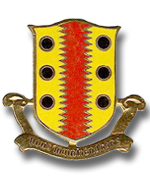 6th Ordnance Battalion DI 6th Ordnance Battalion DI |
|
| (Source: 6th Ordnance Battalion Lineage and Honors) |
The 6th Ordnance Bn was reactivated on 30 June 1948 at Hoersching, Austria and assigned to USFA.
The battalion was inactivated on 17 August 1955 in Austria. |
|
| |
| (Source: STARS & STRIPES, May 18, 1953) |
| Lt Col Ernest V. Lau was CO of the 6th Ord Bn until June 1953. |
|
| |
| Camp Klessheim Ordnance Depot |
| |
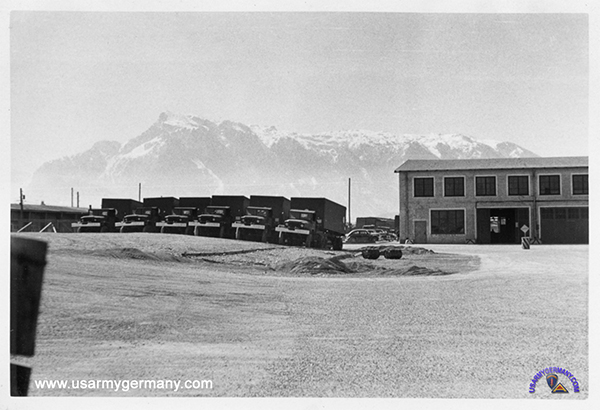
Maintenance shop at Camp Klessheim (Webmaster's collection)
|
| |
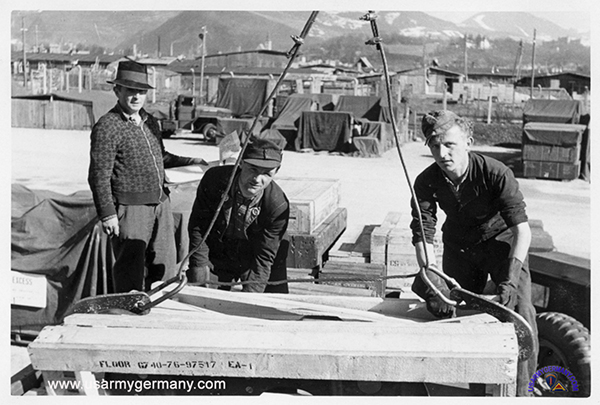
Outdoor storage area, Camp Klessheim (Webmaster's collection)
|
| |
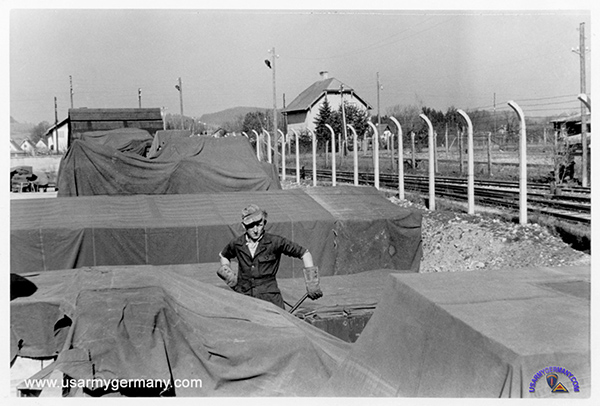
A section of Camp Klessheim next to railroad tracks (Webmaster's collection)
|
| |
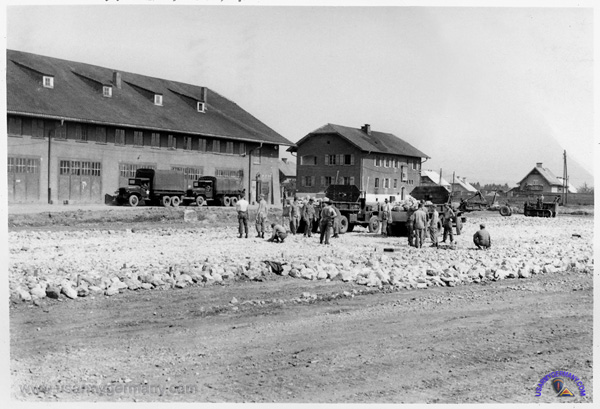
USFA Engineers at work at Camp Klessheim (Melissa Nichols)
|
|
 |
|
| |
| 66th Ordnance Company |
| |
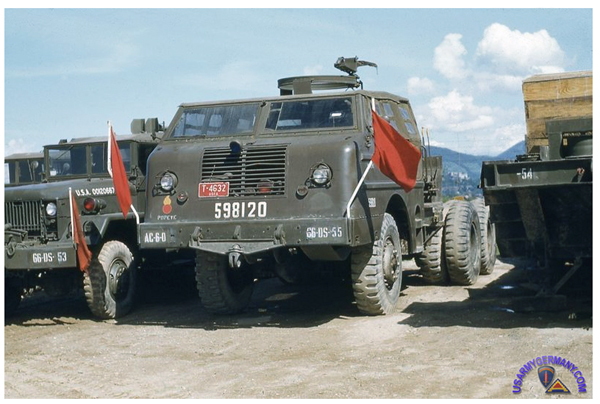
66th Ord Co motor pool at Camp Roeder - in the center of the photo
an
M26A1 tractor used for
hauling tanks and other heavy equipment |
| |
| 1953 |
| (Source: Email from Jim Halsey, 66th Ord Co / 832nd Ord Bn) |
| I have very little in the way of records of my service in USFA and can go only on my memory.
I got to Camp Roeder in October, 1953. I was assigned to the 66th Ord. Co. as a mechanic in the wheeled vehicle repair shop. Our unit also handled tracked vehicle repair, the vehicles being tanks and halftracks.
Sometime after my arrival (I can't remember when) we were redesignated as the 832nd Ord Bn. We were divided into two Companies (A & B) on paper but our mission, manpower, shops, equipment and barracks remained unchanged. I have no idea why the change in unit designation was made.
When I rotated home in June, 1955, the unit was still known as the 832nd. During my time at the 66th/832nd I quickly found that I didn't care for life in the shops and talked my way into a job as company cook. My career as a cook was cut short by an emergency leave to the States; when I returned I found the slot filled so I became ! an armorer.
So much for army career planning. Anyway, I had fun, made some good friends and grew up. During my stay, the U.S. occupation of Trieste, Italy ended and our unit received a number of guys from there. They were all good men and fun to be with. I fell in with a couple of them who were from South Philadelphia (Philly). Being from New Jersey, I had something incommon with them, namely the Jersey shore (particularly Wildwood). You'd have to be from these parts to appreciate that. |
|
 |
|
| |
| 413th Ordnance Company |
| |
| (Source: STARS & STRIPES, April 27, 1952) |
The 413th Ordnance Co, a Kentucky NG unit, recently arrived in USFA from the US to and has been attached to the 6th Ord Bn.
The company is stationed at Camp McCauley in Hoersching and is responsible for providing maintenance support for weapons as well as full-tracked and combat vehicles. |
|
 |
|
| |
| 437th Ordnance Company (Ammunition) |
| |
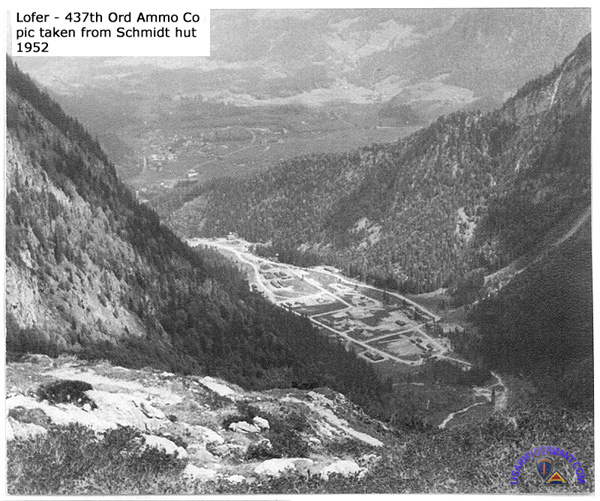
Camp Lofer - ammo storage area seen from the Schmidt(-Zabierow) Hütte, 1952 (Jim Cook) |
| |
| 1954 |
| (Source: Email from Gordon Robbins) |
Regarding the 437th (Ordnance) Detachment (in Bolzano, Italy - see below).
I spent about 6 weeks with them - probably in the early fall of 1954 - until I came down with amoebic dysentery and was medically evacuated to the military hospital in Salzburg. I spent the rest of my tour in Lofer until the peace treaty was signed.
I was assigned to USFA in July 1954 as a brand new second lieutenant right out of the Ordnance School at Aberdeen Proving Ground. During home leave before leaving for Austria, I got married and my new bride and I got concurrent travel to Lofer through Salzburg.
We lived in Saalfelden (just down the road from Lofer) and I commuted to work, so to speak. It was about a 15 mile trip one way as I recall. The countryside was just lovely and, coming from California, I had never seen so much greenery in my life. I was amazed and dazzled. I was only in Lofer a couple of months, as I recall, when I was reassigned to the detachment in Bolzano.
I did a lot of traveling around the area, visiting some of the earlier sites where the ammo was stored - Dobbiaco (Toblach), Brunico (Bruneck) and Cortina d'Ampezzo (yes, the same place the winter Olympics were held a few years later) - over toward Austria.
From Bolzano, driving north toward the Brenner Pass, I recall names like Bressanone (Brixen), Fortezza (Franzensfeste), Campo di Trens (Freienfeld), and Vipiteno (Sterzing). I spent a couple of weeks in Vipiteno, a very colorful Alpine village, supervising the platoon unloading ammo from railroad cars and storing it in temporary bunkers. Another group was working up toward the Swiss border.
I can remember driving up through Merano (Meran) to reach Spondigna (Spondinig). I may not have all the names right. It's amazing how all this comes back to me while looking at an atlas.
The people in the area didn't care much for Americans. I can remember walking along in Bolzano, and being spit upon by a young man. I couldn't understand what he said. There was a detachment of Italian Alpine troops in the area (Alpini's??), and they were the sorriest looking soldiers - they looked like they slept in their uniforms and needed haircuts and shaves.
Anyhow, I really felt fortunate to have spent my army tour in that part of the world. Almost all of my Aberdeen class were sent to Korea as Ordnance Ammunition Officers. One other guy, as I recall, was assigned to USAREUR and I was assigned to USFA. That's about it for the moment. |
|
 |
|
| |
| Linz Ordnance Depot (Linz-Wegscheid) |
| |
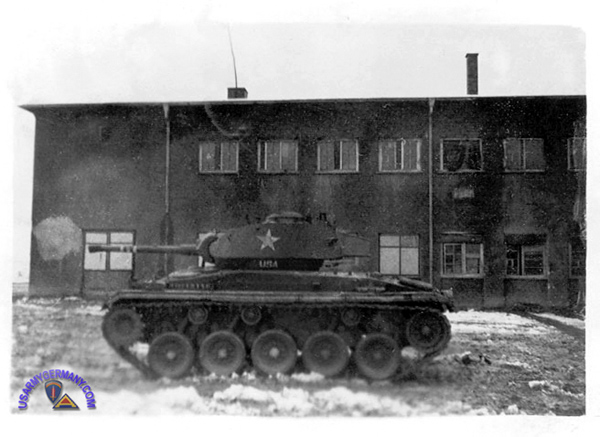
M-24 light tank in rear of Linz Ord Depot, Dec 1946 (Walter Elkins) |
|
|
 |
|
| |
| Vienna Ordnance Center |
| |
The Vienna Ordnance Center was located in the (requisitioned?) facilities of the former Automobile Factory "Gräf und Stift" at Weinberggasse 60-78 (Döblingen). (The olf factory was eventually torn down sometime after the US Army left and a large apartment complex - Franz-Weber-Hof - was constructed on the site in the early 1980s. Wiki)
Letter, Headquarters United States Forces in Austria, file AG 700 MED, subject: Medical Care in the Vienna Community, dated 31 March 1949, states that a USFA sub-dispensary was located on the premises, at Weinbberggasse 76. It was reserved for use by Austrian personnel of the Ord Center. |
|
|
|
| 1954 |
| (Source: STARS & STRIPES, November 4, 1951) |
US Army Emergency Truck Patrols Between Vienna and Linz
Driving the Army's "Good Samaritan" truck behind the Iron Curtain is an ex-sailor who speaks the Navajo Indian language.
Sgt Charles DeLauriss, the ex-sailor, and Pfc Albert P. Meckes alternate the 110-mile run between Vienna and Linz, driving the three-quarter-ton truck to take care of road emergencies involving Americans.
"Most of the time it's just pushing a truck," says DeLauriss. "But once in a while something happens to make it interesting."
He'll probably never again get the jolt he received the first day he started on the job about a year ago. The surprise came when he stopped at the Grüner Baum gasthaus in Melk where the Soviets permit American drivers to eat.
"Not only does the owner speak American - but his speech has a touch of New York," DeLauriss said.
The owner, Robert Navorka, at one time owned a restaurant in New York in addition to having lived in England and Italy. He now receives a fuel and money allotment from the U.S. for feeding the American drivers.
"Of course Navorka doesn't have much to say. We call him Pop. But it breaks the day to speak a few words in English," DeLauriss said.
DeLauriss and Meckes have been the only men on the job since Aug. 6, when the 32nd Ord Depot took over the detail. Formerly the Linz Depot maintained one crew which operated a two-and-a-half-ton truck between Linz and Melk, while the Vienna Regional Ordnance Center maintained another truck for the Vienna-Melk portion of the operation.
DeLauriss still wonders about the Frenchman who, with his wife, one day hitchhiked a ride after cracking up his motorcycle. The Frenchman got across the idea he didn't care about the wrecked motorcycle. He just wanted out of the zone, said DeLauriss.
Sometimes he and Meckes get real satisfaction out of the job. About three months ago, for example, DeLauriss came across an Austrian woman who was lying injured in a wrecked car. Her husband had gone for help. DeLauriss assisted her into the truck and drove to Enns for medical help.
The two American soldiers will stop to give service to anyone who wants it. They carry gas, spare parts and towing equipment. Both men are mechanics capable of taking care of the usual run of mishaps which cause road breakdowns.
Up until Aug. 6, the two trucks had driven about 250,000 miles since the emergency truck procedure was set up after the war, according to Lt Eugene A. Bruski, administrative officer of the Vienna Regional Ordnance Center.
|
 |
|
| |
| Lambach Ordnance Ammunition Depot |
| |
| (Source: Letter, Subj: Machine Tools at the Lambach Ammunition Depot, dated 25 Oct 1948, 6th Ord Bn at NARA) |
About September or October 1945, the MUNA Lambach (a former Luftwaffe ammunition depot) was requisitioned for Ordnance operations in USFA.
It appears that the MUNA was officially designated as "CEM Point No. 2, Lambach" at that time.
(CEM = Captured Enemy Materiel)
At some point a detachment of the 7735 Civilian Supply Company became responsible for operations at the depot.
|
|
 |
|
| |
Related Links:
|
| |
| |
| |


 6th Ordnance Battalion DI
6th Ordnance Battalion DI 


